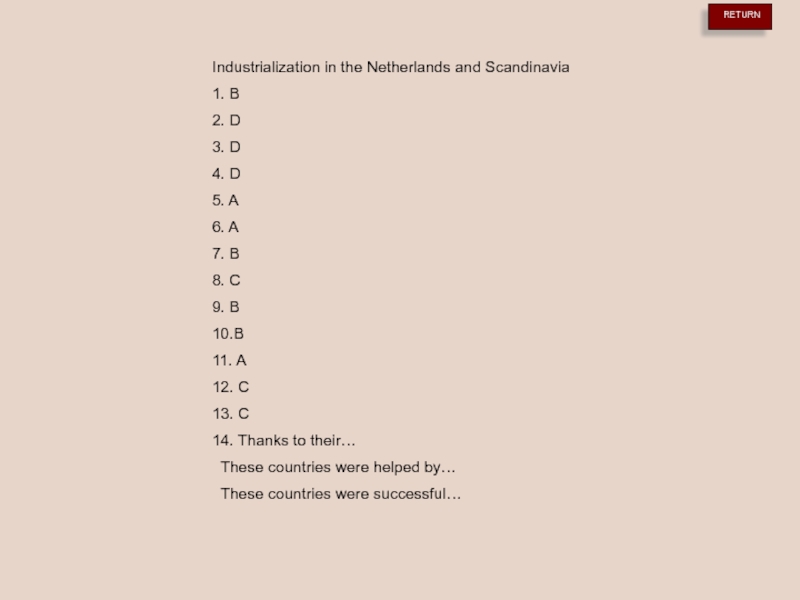- Главная
- Разное
- Дизайн
- Бизнес и предпринимательство
- Аналитика
- Образование
- Развлечения
- Красота и здоровье
- Финансы
- Государство
- Путешествия
- Спорт
- Недвижимость
- Армия
- Графика
- Культурология
- Еда и кулинария
- Лингвистика
- Английский язык
- Астрономия
- Алгебра
- Биология
- География
- Детские презентации
- Информатика
- История
- Литература
- Маркетинг
- Математика
- Медицина
- Менеджмент
- Музыка
- МХК
- Немецкий язык
- ОБЖ
- Обществознание
- Окружающий мир
- Педагогика
- Русский язык
- Технология
- Физика
- Философия
- Химия
- Шаблоны, картинки для презентаций
- Экология
- Экономика
- Юриспруденция
Test TPO 18. Industrialization in the Netherlands and Scandinavia. (Section 1) презентация
Содержание
- 1. Test TPO 18. Industrialization in the Netherlands and Scandinavia. (Section 1)
- 2. You can use the countdown timer at
- 3. Set the timer before doing
- 4. Question 1 of 14
- 5. Question 2 of
- 6. Question 3
- 7. Question 4
- 8. Question 5
- 9. Question 6
- 10. Question 7
- 11. Question 8
- 12. Question 9
- 13. Question 10
- 14. Question 11
- 15. Question 12
- 16. Question 13
- 17. Question 14
- 19. Congratulations! You have completed this practice test.
- 20. Industrialization in the Netherlands and Scandinavia
- 21. Are you sure you want to exit
Слайд 2You can use the countdown timer at the left bottom corner
press this button to set the timer
pause countdown
Input a number
start countdown
Слайд 3
Set the timer before doing the test. Standard time for doing
If you cannot see the timer or if you cannot set the timer, you’ll need to install flash player. Visit http://get.adobe.com/flashplayer/ to download and install adobe flash player.
Слайд 4
Question 1 of 14
Paragraph 1 is marked with ◆
Paragraph 1
They were completely industrialized by the start of the nineteenth century.
They possessed plentiful supplies of coal.
They were overtaken economically by the Netherlands and Scandinavia during the early nineteenth century.
They succeeded for the same reasons that the Netherlands and Scandinavia did.
Слайд 5
Question 2 of 14
Paragraph 2 is marked with ◆
Paragraph 2
It was a more important factor than population size.
It was more influential than the rate of population growth.
It was more important in the early stages than it was later.
It was not a significant factor.
Слайд 6
Question 3 of 14
Paragraph 2 and 3 are marked with ◆
According to paragraphs 2 and 3, which of the following contributed significantly to the successful economic development of the Netherlands and of Scandinavia?
The relatively small size of their populations
The rapid rate at which their populations were growing
The large amount of capital they had available for investment
The high proportion of their citizens who were educated
Слайд 7
Question 4 of 14
Paragraph 4 is marked with ◆
According to
low-cost transportation of goods
access to fish
shipbuilding industrial
military control of the sea
Слайд 8
Question 5 of 14
The word “exceptional” in the passage is closest
extraordinary
surprising
immediate
predictable
Слайд 9
Question 6 of 14
The word “abolished” in the passage is closest
ended
raised
returned
lowered
Слайд 10
Question 7 of 14
Paragraph 5 is marked with ◆
According to
generally liberal trade policies
huge projects undertaken by the state
relatively uncorrupt governments
relatively little social or political disruption
Слайд 11
Question 8 of 14
The word “progressive” in the passage is closest
rapid
partial
increasing
individual
Слайд 12
Question 9 of 14
The author includes the information that "a protectionist
support the claim that the political institutions of the four countries posed no significant barriers to industrialization or economic growth
identify an exception to the general trend favoring liberal trade policy
explain why Sweden industrialized less quickly than the other Scandinavian countries and the Netherlands
provide evidence that agricultural reforms take place more quickly in countries that have a liberal trade policy than in those that do not
Слайд 13
Question 10 of 14
Which of the sentences below best expresses the
The early industrializes controlled most of the international economy, leaving these countries to stake out new areas of specialization along the margins.
Aided by their high literacy rates these countries were able to claim key areas of specialization within established international markets.
High literacy rates enabled these countries to take over international markets and adapt the international division of labor to suit their strengths.
The international division of labor established by the early industrializes was well suited to these countries, a key factor in their success.
Слайд 14
Question 11 of 14
Paragraph 6 is marked with ◆
According to
lacked stability
were not well suited to agricultural products
were largely controlled by the early industrializes
led to slower growth of local industries
Слайд 15
Question 12 of 14
Paragraph 6 is marked with ◆
According to
A steadily rising national income
Greater control over market fluctuations
High returns when things went well
A reduced need for imports
Слайд 16
Question 13 of 14
Where would the sentence best fit?
■
■ 2
■
■ 4
Look at the four squares [ ] that indicate where the following sentence could be added to the passage
During this period, Sweden had the highest rate of growth of output per capita of any country in Europe, and Denmark was second.
■ 1
Слайд 17
Question 14 of 14
Directions: An introductory sentence for a brief summary
To review passage. Click View Text
●
●
●
Answer Choices
Слайд 19Congratulations!
You have completed this practice test.
Exit the test
Review your answer
Obtain
Слайд 20
Industrialization in the Netherlands and Scandinavia
1. B
2. D
3. D
4. D
5. A
6.
7. B
8. C
9. B
10.B
11. A
12. C
13. C
14. Thanks to their…
These countries were helped by…
These countries were successful…
Слайд 21Are you sure you want to exit the test?
YES
NO
Exit the test.
Return to the last question and resume doing the test.


























